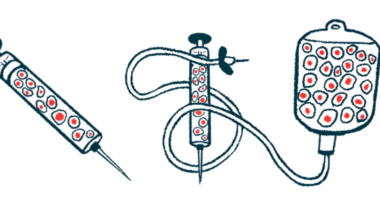Lasting benefits of bemdaneprocel for Parkinson’s seen in Phase 1 trial
New 3-year data show favorable safety profile for stem cell therapy

Bemdaneprocel, a novel stem cell-derived therapy being developed by Bluerock Therapeutics, maintained a favorable safety profile and good tolerability in people with Parkinson’s disease over three years in a Phase 1 trial, new data show.
Importantly, the long-term findings from the completed exPDite study (NCT04802733) also show persistent motor benefits, with stronger improvements seen in patients who received the experimental therapy at a higher dose.
“The results for bemdaneprocel after 36 months mark another motivating milestone,” Christian Rommel, PhD, head of research and development at the pharmaceutical division of Bayer, which owns Bluerock, said in a company press release.
Rommel said the data “reinforce our commitment to developing urgently needed new treatment options for Parkinson’s patients.”
The results were presented last week at the 2025 International Congress of Parkinson’s Disease and Movement Disorders, in Copenhagen, Denmark.
Gabriel Belfort, MD, PhD, senior vice president and bemdaneprocel product lead at Bluerock Therapeutics, said “the 36-month data from this Phase [1] study [underscore] our hope that bemdaneprocel could be a potentially meaningful and durable therapeutic option for treating people living with Parkinson’s disease.”
Parkinson’s disease develops when dopamine-producing neurons (nerve cells) in the brain gradually degenerate. Dopamine is an essential neurotransmitter involved in regulating movement, so its decline leads to the motor symptoms that mark the disease.
The current standard of care — levodopa and related medications — works by replenishing dopamine levels. While these treatments are effective for symptom control, many patients eventually experience off periods, during which symptoms return despite medication.
Bemdaneprocel requires surgery to transplant cells into brain
Bemdaneprocel is designed to replace the dopamine-producing neurons lost in Parkinson’s. The therapy involves surgically transplanting dopamine-producing nerve cells into the brain, with the aim of restoring neural function and easing motor symptoms.
The dopamine-producing nerve cells are derived from human embryonic stem cells.
The exPDite Phase 1 trial assessed the safety and effectiveness of bemdaneprocel in 12 adults with Parkinson’s disease who continued to experience off episodes despite ongoing levodopa therapy.
The participants were surgically implanted with either a low dose (0.9 million cells) or a high dose (2.7 million cells) of bemdaneprocel into the putamen, a brain region critical for motor control. Five patients received the low dose, and seven were given the high dose. To prevent immune rejection, all patients received immunosuppressive treatment for one year following the procedure.
Data from two years post-surgery indicated no safety concerns related to the use of the cell therapy, even one year after immunosuppression was discontinued.
The newly presented results involve follow-up data collected three years after treatment, providing insight into the therapy’s longer-term impact.
Bemdaneprocel continued to be well tolerated, with no therapy- or surgery-related adverse events reported, according to the developer. Brain imaging scans indicated that the transplanted cells continued to survive and integrate into brain tissue even after immunosuppressive therapy was discontinued at one year, as specified in the study protocol.
Parkinson’s patients in small trial see increase in good on time
Moreover, the researchers noted that secondary clinical outcomes related to motor function continued to show positive trends, as assessed by changes in parts II and III of the MDS-Unified Parkinson’s Disease Rating Scale, and the Parkinson’s Disease Diary.
Motor symptoms in patients in the high-dose group during off periods showed a mean reduction of 17.9 points from baseline, or the study’s start. In patients in the low-dose group, the mean reduction was 13.5 points. According to the press release, both changes are considered clinically meaningful.
Using the Parkinson’s Disease Diary, a tool for tracking daily motor symptoms and treatment response, participants in the high-dose cohort reported a mean increase of one hour in good on state when compared to the beginning of the study. Good on state refers to periods of time when a patient experiences satisfactory control of their motor symptoms due to the optimal effect of levodopa. Two participants in this group did not complete the 36-month assessment.
Additionally, in this group, time spent in the off state decreased by nearly one hour (-0.93 hours) on average from baseline.
Those in the low-dose group experienced a mean increase of 0.23 hours in good on time and a mean reduction of 1.15 hours in off time, as compared with the beginning of the study.
The new [three]-year data is a critical next step to evaluate longer-term safety. … While there is a need for caution in interpreting the positive trends in clinical outcomes, initial signals are there, particularly in the higher dose cohort.
Daily living activities, measured using the MDS-UPDRS Part II, also showed a mean decrease of 4.3 points from baseline in the high-dose cohort. That finding suggests these patients had an improved ability to manage day-to-day tasks with the treatment. In contrast, the low-dose group recorded a slight mean increase of 0.2 points, indicating no meaningful change.
All patients who completed the exPDite trial can take part in a five-year extension study (NCT05897957), now enrolling, that will continue to monitor safety and clinical outcomes.
“Bemdaneprocel represents a new approach to restoring the dopamine inputs that are lost in Parkinson’s, and leverages substantial advances in stem cell technology,” said Claire Henchcliffe, MD, one of the study’s principal investigators and chair of neurology at the University of California, Irvine. “The new [three]-year data is a critical next step to evaluate longer-term safety.”
Henchcliffe noted that, “while there is a need for caution in interpreting the positive trends in clinical outcomes, initial signals are there, particularly in the higher dose cohort.” The scientist added that “the upcoming exPDite-2 clinical trial should shed further light on potential benefits.”
New Phase 3 trial testing bemdaneprocel enrolling in US
That trial, a registrational Phase 3 study (NCT06944522), is designed to obtain sufficient data to support regulatory approval for bemdaneprocel. It’s now recruiting up to 102 patients, ages 45 to 75, at 10 locations in the U.S.
Belfort said the company is “committed to advancing bemdaneprocel through the next stage of clinical testing.” The scientist also said the company is “excited to share these [new trial] data with the Parkinson’s disease community.”







